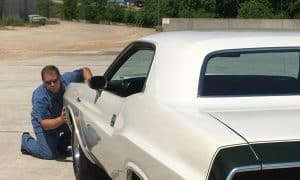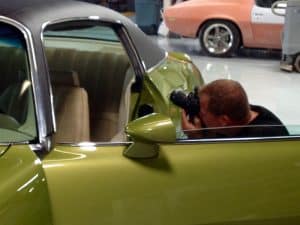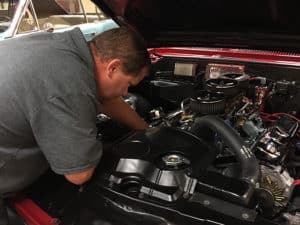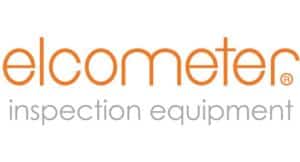There are many things that should be taken into consideration before purchasing your classic car one of them is obviously the condition of the car overall. I have written this article geared towards things which can help you when inspecting a classic car before purchase.
The most common area that people can inspect on a classic car is the body. This is really the classic car’s first impression on the potential buyer.
- Does the paint provide a good shine in direct and indirect lighting?
- Are there a lot of light scratches in the finish from buffing?
- Does the body show any waves in the paint finish especially under the doors and behind the rear wheels on the quarter panels?
- How to the body panel seams and lines match up? Do they appear even, well-spaced out and smooth?
- How does the chrome and trim appear on the car? Are there scratches and dents from reinstallation, is there paint lines from being taped around during a repaint or was the trim fully removed as it should have been?
- This also a good time to inspect the tires. Do the tires look like they have good tread on them? Do the front tires have the same life remaining as the rears? Do the rears have much less than the fronts? This could be a sign that the car has been hot rodded a lot and the rear tires spun often.
The next area that people inspect on a classic car is often the interior. This is the second impression on a potential buyer.
- Is the interior clean and free of dust?
- Is the interior complete? Is it missing any parts such as the stereo, gauges or trim?
- Are the seats soft to the touch or dry and hard?
- Is the carpet clean and in good condition or is it dirty and worn?
- Is the headliner clean and in good condition or is falling from age?
- Is the dash in good condition or does it have cracks and scratches on it?
- Does the dash cluster and odometer appear to have been removed or replaced?
- I prefer to check the glass condition from the inside out. Besides the obvious chips and stars in the wiper arc area of the glass be certain to check down in the corners and edges of the glass for any chips and cracks forming. Don’t forget to check ALL THE GLASS in the car including the side windows, rear windows, quarter windows and rear windows.
- If this is a convertible be sure to raise the top and inspect how the windows seal to the top and the condition of the rear corners.
- Don’t forget to open the trunk and inspect for the spare tire and tools and for any water damage in the cargo area.
If the previous areas check out on a classic car the potential buyer often moves deeper into inspecting the car. Next, a classic car buyer would likely move into the mechanicals of the car and open the hood.
- Do all the parts appear to be present such as the AC compressor if the car has the AC option?
- Is the air cleaner fully installed? An air cleaner that is loosely installed often means the car has starting issues and must be primed when starting.
- What is the condition of the hoses and belts? Do they seem soft and new or dry and hard?
- Are there any obvious signs of leaks? Most common area of leaks is the valve covers and around the carburetor. Be sure to check the heads where they meet the engine block for leaks. Also, the front and rear of the motor. Another common area for leaks is the lower rear of the engine where the oil pan meets the block.
- Is there corrosion on the battery? Is there corrosion under the battery?
- Is the engine compartment clean?
- Is the wiring tidy and well routed?
- Be sure to check all the fluid levels and for the condition of the fluid. Engine Oil, Transmission Fluid, Coolant, Brake Fluid, Power Steering Fluid. All the oils and fluids should be clean and mostly clear. If you see any signs of milky substances or the smell of burnt rubber walk away.
Once you have done some basic inspecting of the vehicle now it is time to start it up and get it warmed up. Once you get it started here are some things to be paying attention to.
- Did the car start easily or did it need jump started?
- Did the car require several attempts in starting? Did it start right up with only a couple pumps of the gas pedal?
- Once started how did the car idle? Did the idle smooth out after a few moments or did it still require feathering the gas pedal?
- If the car is equipped with an oil pressure gauge did the oil pressure respond with more engine RPM? IF NOT SHUT IT DOWN and have the seller put a pressure gauge on the engine directly to verify oil pressure.
- Once warmed up did the choke open and the idle settle down to a normal level?
- While running was the engine rotating smoothly or did it feel rough and rigid? Did you hear or feel any knocking or tapping from the engine area? Did you hear of feel any taping or grinding under your feet near the transmission?
- Be sure to let the car warm up completely where the engine temperature gauge reads in the middle. Did the temp gauge respond? Did the engine maintain a regular temperature or did it move past the middle at idle?
- While the car is running is a good time to check all the lights and signals. Turn on all the lights including the high beams and do a brief walk-a-round of the car and ensure all the lights are in working order. Good time to check the other options as well such as the windows, locks, wipers, radio etc.
- Once the engine is warmed up take it out for a test drive.
Test driving the classic car is often the most fun part of purchasing a classic car. Here are some things to look and feel for during your test drive.
- How does the steering feel? It should be tight and have very little free play if any at all. There should be no noises under the car as you turn the wheels side to side.
- Does the engine respond well to throttle?
- If the car has an automatic transmission, how did it feel when it shifted into gear? Was it smooth and fast or did it take a while and slam into gear? Did you have to apply more pressure to the brake pedal once in gear or did the brakes hold it as it was in drive?
- If the car is equipped with a manual transmission does the clutch pedal feel solid? How much free play is in the clutch pedal? 1-2 inches is about average. Too tight of a clutch will prematurely wear the clutch disc out. Did the clutch engage the transmission at a decent pedal height? The transmission should begin grabbing about 1/3 pedal height from the floor, if not engaged at ½ pedal height from the floor then the clutch likely needs replaced.
- When moving and shifting through gears does the transmission smoothly shift into the next gear and hold it or does it grind or slip?
- Once you are moving be sure to test the brakes before leaving the parking lot. Does the brake pedal feel solid and have good pressure behind it or does it feel spongy and too soft like it falls to the floor? Did the brakes stop the car? Was there any noise or grinding during your test stop? Be sure to do a test stop in reverse as well to check for loose calipers and retainer clips. If there are loose brake components you will hear them clunk as soon as you press the brake pedal.
- Now it is time to get moving through you test drive. You will want to ensure you take the car up to full speed at which you expect it to perform at.
- Go for a few quick starts then slowly accelerate through some others. Did the engine hesitate at all when you gave it throttle while in gear?
- Did the car easily shift through gears to reach your expected maximum speed?
- What speed did the car reach? 55 MPH? 65 MPH? 70 MPH?
- Did the engine RPM’s move up with speed as expected and the vehicle shift smoothly into the next gear at the expected RPM range?
- Did you feel any vibrations in the steering wheel or brake pedal during your drive? This can be signs of flat spotted tires, tire out of balance or the brake rotors or drums being warped.
- Did you feel any vibrations in the floor or your seat during the drive? Vibration in the floors often is cause of suspension issues. Vibration in your seat is often from a worn or loose U-joint in the driveline.
- During your test drive, be certain to take the car down some rougher roads and listen for rattles under the car and in the interior.
- When you return from your test drive of the classic car be sure to pay attention to the engine temperature gauge. Let the car idle for a few minutes prior to shutting it down. The car should maintain a normal temperature and NOT raise into a concerning temp.
- When switching the engine off did the car shut down smoothly or did it continue to want to run and chug or diesel? If it did this is an indication the timing needs adjusted.
- Start the engine back up now that it is hot. Did the car start right back up or did it lug or turn slowly? If it turned slowly this could be an indication that the starter needs heat protection from the headers or exhaust or a new starter.
This is just a few of the many items that need fully examined on a classic car before you purchase it.
Here at Test Drive Technologies we continue much further into a classic car inspection for you by checking the undercarriage, driveline, steering, suspension, brakes, full electricals and a full hands-on inspection of the body and engine. If you ever need advice or any help inspecting a classic car give Steve, the owner of TDT a call for a pre-purchase classic car inspection in St Louis and Southern Illinois.









